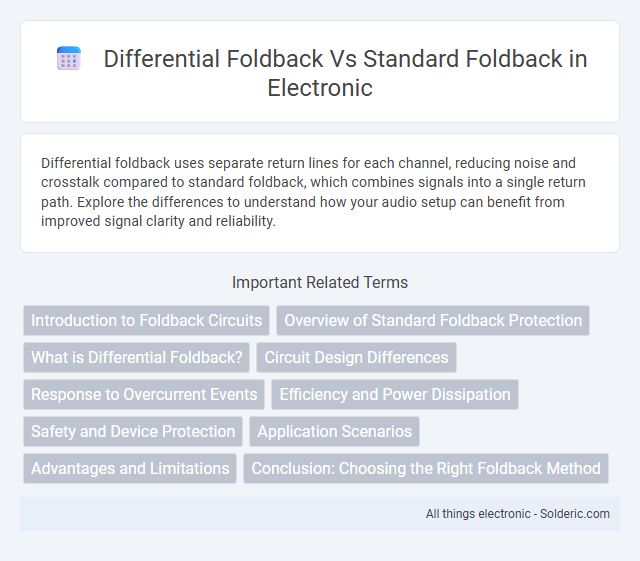Differential foldback uses separate return lines for each channel, reducing noise and crosstalk compared to standard foldback, which combines signals into a single return path. Explore the differences to understand how your audio setup can benefit from improved signal clarity and reliability.
Comparison Table
| Feature | Differential Foldback | Standard Foldback |
|---|---|---|
| Signal Reference | Uses differential signals for accuracy | Uses single-ended signals |
| Noise Immunity | High noise rejection | Lower noise rejection |
| Complexity | More complex circuitry | Simple and straightforward |
| Voltage Accuracy | Higher precision in feedback voltage | Moderate precision |
| Application | High-performance power supplies | Basic power regulation |
| Cost | Higher cost due to added components | Lower cost |
| Implementation | Requires matched differential components | Minimal component requirements |
Introduction to Foldback Circuits
Foldback circuits limit current by reducing output current when a set threshold voltage is exceeded, protecting sensitive components from damage due to overload or short circuits. Differential foldback circuits enhance this protection by using a differential sensing method, where the current reduction is controlled based on the difference between two voltage points, allowing faster and more accurate response to fault conditions. Standard foldback circuits rely on fixed voltage thresholds, whereas differential foldback offers improved stability and precision in current limiting applications.
Overview of Standard Foldback Protection
Standard foldback protection limits current by reducing output current to a fixed low level when an overcurrent condition is detected, protecting the circuit from damage. It uses a single threshold to trigger foldback, resulting in a simple design but possible reduced performance during transient loads. Differential foldback enhances this by employing multiple sensing points to more accurately regulate current and avoid unnecessary foldback activation.
What is Differential Foldback?
Differential foldback is a signaling technique used in electronic communication systems to improve noise immunity and signal integrity by sending a complementary or inverted version of the original signal along with it. Unlike standard foldback, which typically involves a single feedback loop to maintain system stability, differential foldback uses paired signals that help cancel out common-mode noise and interference. This method is especially beneficial in high-speed data transmission and audio amplification applications where preserving signal quality is critical.
Circuit Design Differences
Differential foldback circuits utilize paired transistors to monitor current through both the load and reference paths, enabling precise current limiting by comparing voltage differences. Standard foldback designs typically use a single sensing resistor and transistor to reduce current under fault conditions without differential comparison, resulting in simpler but less accurate control. The differential approach enhances protection by dynamically adjusting the foldback threshold based on real-time load variations, improving reliability in power supply circuits.
Response to Overcurrent Events
Differential foldback offers a more precise response to overcurrent events by continuously monitoring the difference in current between input and output, quickly reducing the power supply output to prevent damage. Standard foldback, in contrast, reduces current based primarily on output voltage drop, causing a slower and less sensitive reaction to overcurrent conditions. Your choice of differential foldback ensures faster protection and improved system stability during fault scenarios.
Efficiency and Power Dissipation
Differential foldback offers enhanced efficiency by precisely regulating current during fault conditions, minimizing unnecessary power dissipation compared to standard foldback methods. Standard foldback reduces output current under fault but can cause higher power losses due to less sensitive adjustments. Differential foldback's responsive operation improves thermal management and overall power efficiency in electronic circuits.
Safety and Device Protection
Differential foldback provides enhanced safety by monitoring voltage and current independently on both halves of a circuit, allowing precise detection of faults and reducing the risk of device damage. Standard foldback typically limits current based on a single parameter, which may lead to slower response times and less effective protection in complex failure scenarios. Utilizing differential foldback results in improved device longevity and minimized thermal stress due to its accurate and rapid fault isolation capabilities.
Application Scenarios
Differential foldback is ideal for high-precision applications such as medical devices and aerospace systems, where noise rejection and signal integrity are critical. Standard foldback suits less complex environments, like consumer electronics, where simple overcurrent protection is sufficient. Choosing the right foldback method ensures your circuit protection aligns with specific operational demands and reliability requirements.
Advantages and Limitations
Differential foldback offers enhanced signal integrity and reduced noise interference compared to standard foldback, making it ideal for high-precision applications. It allows for more accurate feedback and better linearity due to its ability to reject common-mode signals. However, differential foldback circuits tend to be more complex and costly, requiring careful matching of components to avoid imbalances, whereas standard foldback designs are simpler and less expensive but more susceptible to noise and distortion.
Conclusion: Choosing the Right Foldback Method
Differential foldback offers enhanced signal accuracy and noise reduction compared to standard foldback, making it ideal for high-precision audio and electronic applications. Standard foldback remains a cost-effective choice for less demanding environments where simplicity and basic functionality are sufficient. Selecting the appropriate foldback method depends on the specific requirements for signal integrity, environmental noise levels, and budget constraints.
differential foldback vs standard foldback Infographic

 solderic.com
solderic.com